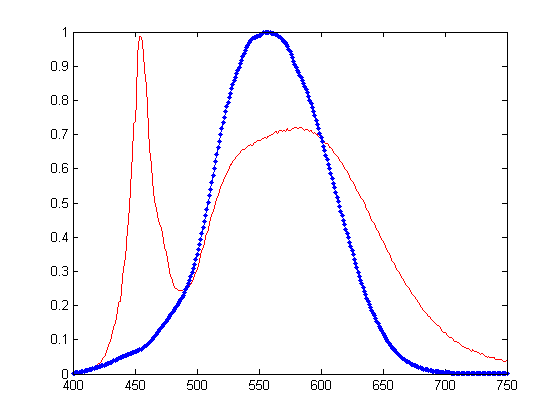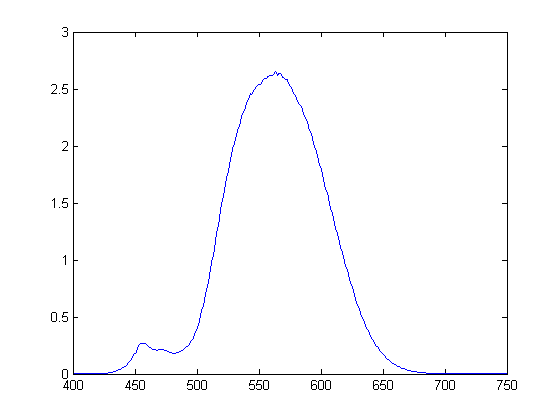mux
Newly Enlightened
I'm busy with feasibility on an SSL project and I'm trying to do it as scientifically valid as possible. I know that basically the most knowledgeable people when it comes to LED tech live on this forum (and AVSforums), so as a change from my normal lurking behaviour I decided to register and ask my question here.
I want to calculate the electrical efficiency, not efficacy, of a Cree XM-L LED. Actually, I did it already. It's 37.16%. I think it's not right, but I don't know where it might have gone wrong. Or maybe I do. I'll walk you through the process. It's about the cree neutral white (5000K CCT) XM-L LED. Here's the datasheet.
Cree provide in their datasheets a graph of relative spectral power density (page 3, top). It's not unambiguously telling me, but I assume this is in (normalized to 100%) W/m.
This means that I should be able to scale this to the CIE photopic curve and get photopic lumens. Again I assume photopic, but I'm pretty damn sure they're not using scotopic or hybrid lumens. So I extracted the spectral power density for neutral white as well as the CIE photopic curve and read them into Matlab. Here they are:

Red=XM-L datasheet curve, blue=CIE photopic curve
Then I multiplied them together to get the (unscaled/relative) photopic luminous spectral density:

Now I reasoned that I should scale this curve by a factor such that the integral of the curve becomes the amount of lumens quoted in the flux bin, e.g. I should scale it such that it sums up to 260 lumen for a T5 bin.
After that, I can go back: if I divide again by the CIE photopic curve, taking into account that the peak should be 683.002 lm/W and not 1 as I showed in the first picture (yes, I took that into account), I will get a scaled curve for the spectral power density in absolute W/m. Right?
So when I integrate that curve, I should get photon watts. The actual photons leaving the device, and their associated power. Well, if I do that for the XM-L neutral white T5 at 700mA, I get a photon power of 0.7543W. The current is 700mA and if we look at forward voltage vs. current, you can see the forward voltage at 700mA is about 2.9V. That means the input power is 2.03W. I can now draw the conclusion that 0.7543/2.03=37.16% of electricity is radiated as photons and 2.03-0.7543=1.2757W is dissipated as heat (62.84%, but that seems to obvious to write down (damn, I did it anyway)). Mind you, I'm really just talking about efficiency, not efficacy, obviously a UV LED may be very efficient but not effective because we can't see any of it's radiation.
Is this the correct method and the correct outcome? If so, this is absolutely remarkable. Also, thanks to Cree's datasheets we can actually derive this.
I'd like to extend this derivation to maximum theoretical efficiency and other general silicon-oriented performance metrics (and thus a way to calculate the internal droop/extraction efficiency/etc.) but first I want to know if this is correct.
I want to calculate the electrical efficiency, not efficacy, of a Cree XM-L LED. Actually, I did it already. It's 37.16%. I think it's not right, but I don't know where it might have gone wrong. Or maybe I do. I'll walk you through the process. It's about the cree neutral white (5000K CCT) XM-L LED. Here's the datasheet.
Cree provide in their datasheets a graph of relative spectral power density (page 3, top). It's not unambiguously telling me, but I assume this is in (normalized to 100%) W/m.
This means that I should be able to scale this to the CIE photopic curve and get photopic lumens. Again I assume photopic, but I'm pretty damn sure they're not using scotopic or hybrid lumens. So I extracted the spectral power density for neutral white as well as the CIE photopic curve and read them into Matlab. Here they are:

Red=XM-L datasheet curve, blue=CIE photopic curve
Then I multiplied them together to get the (unscaled/relative) photopic luminous spectral density:

Now I reasoned that I should scale this curve by a factor such that the integral of the curve becomes the amount of lumens quoted in the flux bin, e.g. I should scale it such that it sums up to 260 lumen for a T5 bin.
After that, I can go back: if I divide again by the CIE photopic curve, taking into account that the peak should be 683.002 lm/W and not 1 as I showed in the first picture (yes, I took that into account), I will get a scaled curve for the spectral power density in absolute W/m. Right?
So when I integrate that curve, I should get photon watts. The actual photons leaving the device, and their associated power. Well, if I do that for the XM-L neutral white T5 at 700mA, I get a photon power of 0.7543W. The current is 700mA and if we look at forward voltage vs. current, you can see the forward voltage at 700mA is about 2.9V. That means the input power is 2.03W. I can now draw the conclusion that 0.7543/2.03=37.16% of electricity is radiated as photons and 2.03-0.7543=1.2757W is dissipated as heat (62.84%, but that seems to obvious to write down (damn, I did it anyway)). Mind you, I'm really just talking about efficiency, not efficacy, obviously a UV LED may be very efficient but not effective because we can't see any of it's radiation.
Is this the correct method and the correct outcome? If so, this is absolutely remarkable. Also, thanks to Cree's datasheets we can actually derive this.
I'd like to extend this derivation to maximum theoretical efficiency and other general silicon-oriented performance metrics (and thus a way to calculate the internal droop/extraction efficiency/etc.) but first I want to know if this is correct.

